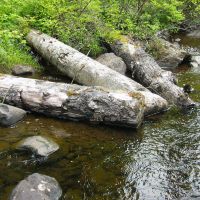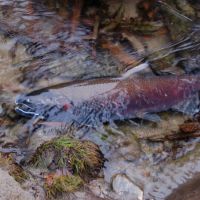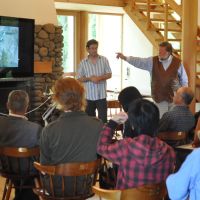I recently had the pleasure of my eldest daughter, Miwako, coming to stay at my Kurohime home in the Nagano Prefecture hills together with her partner, Don McCubbing, and their 4-year old twin daughters Aila and Zanti.
Miwako and Don met when she was coordinating a television documentary I did for the Hokkaido Broadcasting Company on bears, salmon and their relationship to forests.
Don was born in Edinburgh in 1966, and moved to Sheffield, in the English county of Yorkshire, at the age of 10. As a small boy he was drawn to the outdoors and loved to walk on the northern English moors with his dog, exploring, playing in the streams and letting his imagination roam free. It didn't take him long to become an avid fisherman.
After graduating in biology from Nottingham University in central England, he went on to do research on salmon and trout and to gain a master's degree from King's College, London.
With that piece of academic paper in his pocket, Don then moved some 450 km north to England's famously scenic Lake District. There, working now for the Fisheries Technical Office of the Environmental Agency, he was tasked with studying the biology of 10 major lakes and rivers.
However, what he found was a lack of communication between the people living there and the government — so he instigated a series of public meetings to discuss his findings and to listen to the opinions and observations of the locals. It was a move that did not make his superiors too happy.
I can really sympathize with this. Here in Japan, government officials will hold setsumei kai (explanation meetings) in which they, quite simply, dictate to the locals. Those meetings are not meant to be discussions at all.
Anyway, at a conference in the North Sea fishing port of Hull, Don met Dr. Bruce Ward, a leading Canadian fisheries expert who, at the time, was conducting a 20-year study of steelheads in the Keogh River of northern Vancouver Island.
Steelheads are actually rainbow trout that have been able to migrate from rivers to the ocean, and which, like other salmonids, return to their native rivers to spawn and die.
However, compared to river- or lake-dwelling rainbow trout, which can get very large and very fat (up to 20 kg), steelheads are ocean-going marathon athletes that are slender and muscular and glory in a bright, steely sheen. Amazingly, they appear totally different from the colorful spotted rainbow trout with lovely pink lateral stripes to which they are genetically identical.
Traditionally, too, steelheads were much sought after by anglers, but in Canada they are now totally protected.
Don was encouraged to go to Canada to work on the Keogh, a short, fast river badly damaged due to the erosion and flooding caused by thoughtless logging projects. Up until the 1960s, it was common practice in British Columbia — and indeed, in many other forested regions of Canada and the United States — to strip old-growth forest bare, right up to the rivers.
Coastal British Columbia is known for heavy snows and torrential rains, and on old-growth slopes that have been clear-cut, water rushes down, carrying soil, gravel, boulders, tree stumps and other woody debris left after logging. This would cause rivers like the Keogh to flood, carrying away the habitat of fish and other aquatic wildlife. Then, as the waters subsided, huge mounds of gravel and rocks would be left behind in testament to the floods.
In such damaged rivers, during summer the flow of water can actually vanish from sight, running under rock and gravel. In times of flood, the rushing, raging waters carry away stream banks and bring even more sand, silt, gravel, rocks and woody debris.
Healthy salmon and trout streams are stable because the forest and the stream-bank vegetation control the flow of water. Clear-cut logging on mountain slopes is short-sighted and can cause enormous damage not only to aquatic habitat and fish populations, but also to human structures such as roads, bridges, pipelines and homes.
Logging policies have somewhat improved in Canada; nowadays loggers are only allowed to cut trees up to 30 meters from a river or stream. Although the public in Canada is well aware of this, pressure from logging companies — combined with (not-incorruptible) local politics — ensures that the struggle for balance will always go on as long as there is money to be made from fish to be caught and trees to be cut.
The Keogh River was a classic case of a river being damaged by logging. Fast flowing, cold, full of oxygen and 37 km long, it was a valuable spawning ground for Coho salmon (Oncorhynus kisutch), fish that are silver sided with dark blue backs when at sea, thus giving them their other name of Silver salmon. However, when Coho return to rivers to spawn, their jaws and teeth become hooked and they develop bright-red sides and bluish-green heads.
Another Keogh fish is the Pink or Humpback salmon (O. gorbuscha) which is silver in the ocean but then develops a pronounced humped back when spawning. And, as already mentioned, the Keogh boasts another salmonid — the steelhead — an anadromous phase of the rainbow trout.
But those aren't all the fish the Keogh River has to offer. There's also a much sought-after sport fish living there in the shape of the Coastal cutthroat char (O. clarkii), which is golden to gray to green on the back with a distinctive reddish mark under the lower jaw that gives it its name.
Beginning in 1996 and lasting for five years, $1-million-worth of of restoration was conducted on the banks of the Keogh and on the river itself. The banks were replanted with trees, especially willows and alders, and structures made of big logs and rocks, sometimes using huge tree trunks, were carefully positioned in the river to create fast-flowing glides, pools, riffles and stable gravel beds for spawning. All the materials used were locally sourced, and absolutely no concrete was used.
The Keogh River has been carefully monitored for 38 years now, with Instream, a consulting company Don formed, latterly taking over the research. As a result, fish weirs and traps for manual sampling and tagging, as well as fish-counters and monitoring systems (all run by solar- and wind-power), record the number of fish coming and going. Then, when a certain number of fish pass through the monitors, underwater cameras switch on automatically to enable the species to be confirmed.
Meanwhile, Don and his researchers and river-habitat engineers also work on rivers in Alaska, the rest of British Columbia, Ontario, and in the U.S. states of Oregon and Washington.
The success of the restoration on the Keogh River can be summed up by the latest run of Coho salmon, which saw more than 100,000 returning fish — the largest run of that species in 38 years.
The pink salmon, steelheads and cutthroat char have also come back in numbers, in turn encouraging an increase in other wildlife such as black and grizzly bears, cougars, wolves, mink, otters and even Harbour seals that swim up the river from the mouth. Fish-eating birds attracted to the new bonanza include eagles, mergansers and kingfishers.
Don recently gave a one-hour talk on his research at our new Afan Woodland Trust Centre in Kurohime — with yours truly doing his best to translate into Japanese.
The informal seminar, to which many locals came along, was attended by Japanese river experts from as far away as Kochi in Shikoku, as well as from neighboring Niigata Prefecture.
However, though they were invited, the prefectural officials now seeking to change the ancient watercourse bordering our woods and the national forest into a sterile concrete sluice were notably absent.
That man-made stream they wish to despoil has, with its clay and rock banks, brought pure mountain water to local rice paddies for at least 200 years. And, in its clear running water, char and other aquatic life thrives. In deadly contrast, a concrete sluice will kill everything.
However, when these officials try to get access through our woods in order to wreak their ugly concrete havoc, this old red devil will dig his heels in.
Japan signed an international treaty at the Convention on Biological Diversity in Rio de Janeiro on June 5, 1992 — a treaty reconfirmed at the Conference of the Parties in Nagoya in 2010 — aimed at halting the destruction of biodiversity. Provincial and sometimes national officials dealing with rivers, streams, watercourses and wetlands seem to think they are immune from this.
We all have to stand up to them. Fish, snails and kingfishers can't speak for themselves.





















With your current subscription plan you can comment on stories. However, before writing your first comment, please create a display name in the Profile section of your subscriber account page.